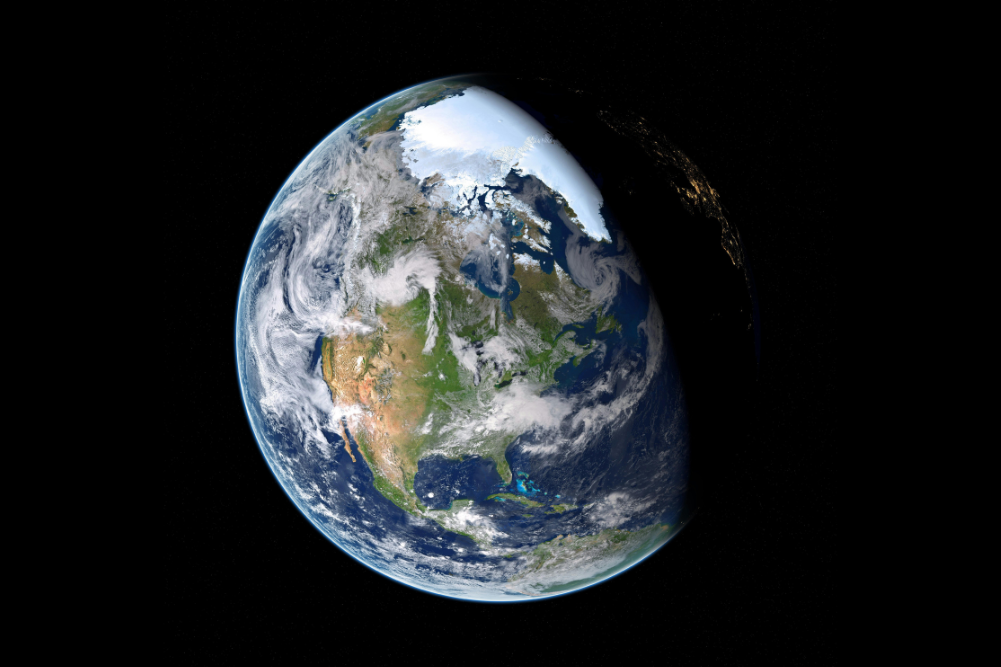Here Comes the Sun
Solar power – harnessing the light from the sun and converting it into electricity using photovoltaic (literally “light electricity”) cells – is a renewable energy source that can combat climate change, an issue that is fast becoming the number one global priority. Solar-powered electricity still represents only a small fraction of the world’s power generation, but it is now receiving serious attention from governments.
When American inventor Charles Fritts produced the first solar cell in 1883, it aroused significant interest, but with a conversion efficiency (the percentage of solar energy that is converted to electrical energy) of around one to two per cent, the business sector did not see it as a viable proposition. Several decades later, in 1954, the US company Bell Laboratories discovered that if the semiconductor silicon is treated with certain impurities, it becomes highly sensitive to light. The company went on to make solar modules that were about six per cent efficient.
During the second half of the 20th century, the use of solar power was mostly limited to stand-alone electricity generators for island and remote communities, spacecraft, ships, roadside signs, calculators and alternative lifestylers living in rural areas. More recently, with the arrival of “grid-connected” solar power in the 1990s and increasing concern about climate change, more and more homeowners began opting for solar installations as a means of feeding surplus power back to the grid.
Silicon is still used by most photovoltaic (solar cell) manufacturers in two or more thin layers of “silicon wafer”. The second most abundant element in the Earth’s crust, silicon is refined from high-silica sand to a very high purity polysilicon, the precursor to the silicon used in solar technology.
Rectangular solar panels consist of a collection of solar cells, each measuring a few square centimetres; each panel is rated at around 80 watts and today’s panels operate with a conversion rate of around 15 per cent. The highest advertised conversion rate is 20 per cent (a minimum efficiency), for products made by the California-based SunPower Corporation. This is achieved by putting the light-reflecting metal contacts on the back of the cell while presenting a uniformly black appearance on the front. Find gardening products on Bunnings Catalogues.
Competing with traditional solar panels, a wide range of “thin film” materials has been under development in recent years. Although these new technologies yield significantly less power than a standard panel, their minimal resource usage results in an extremely low cost. Among thin film research subjects, both cadmium telluride and amorphous silicon are now being manufactured on a commercial scale. Amorphous silicon, in particular, has found a market niche in flexible modules that can be used on curved surfaces where a rigid panel would be unsuitable.
Solar myth-busting
As a power source, solar has attracted its fair share of disparaging comments and misconceptions, many of which have been debunked by experts. One is the claim that during its lifetime a solar panel fails to produce more than the total embodied energy used in its manufacture. In reality, this “energy payback time” is normally less than five years, and in the case of amorphous silicon it can be as little as one year.
Also damaging are attempts by some politicians to portray solar power as a “boutique” method of generating electricity that is largely irrelevant to the nation’s mainstream energy requirements. Former Australian Prime Minister, John Howard, has even referred to solar power as “a solution at the periphery rather than at the centre.” Language can be used to underline the supposed marginal status of solar energy too, by describing it as “alternative” rather than “renewable”.
Coalition politicians frequently tell us that energy generated from photovoltaic sources is not base-load power (electricity generated on a continuous basis.) Their argument is that without a back-up or storage device, solar facilities are unable to provide power after the sun has set. The Greens have criticised this base-load focus, and believe that Mr Howard’s intention is to promote his preferred power sources (coal and nuclear) while consigning everything else to the fringe. Furthermore, Greens Senator Kerry Nettle has drawn attention to the successful use of molten salts as an efficient storage system for the large Solar Two solar thermal power station in California.
Base-load arguments have also been challenged by an unpublished coal research report obtained by The Canberra Times. Solar concentrators are parabolic dishes that generate electricity from heat, and the report expresses the opinion that this solar thermal technology “is poised to play a significant role in base-load generation for Australia.”
When it comes to peak power, solar comes into its own. Air conditioning is now found in 60 per cent of Australian homes, causing sharp spikes in demand on the hottest days of the year. At these times, solar panels will also be generating the most electricity which, if fed into the grid in sufficient quantity, can avert blackouts and even postpone the building of new power stations to meet peak demand.
Choosing to go solar
The attraction of solar power is obvious for many properties located in the Australian bush. The extension of mains power to such a dwelling can cost tens of thousands of dollars, whereas a large solar array with battery back-up can pay for itself within a year.
For the majority of consumers who are already grid-connected, on the other hand, the appeal of solar lies in the achievable fantasy of turning one’s abode into a mini-power station that sells electricity to the grid during the daytime. In pursuing such a dream, many households have succeeded in reducing their power bills below the zero mark – which means they’re selling electricity back to the grid. Depending on your power utility, these net exports can be paid by cheque or added as a credit; credits are paid in cheque form if you decide to switch suppliers or move to another part of the country.
Although solar is most suited to the sun-drenched outback, reasonable results can be obtained throughout Australia. Factors affecting performance include annual hours of sunlight, the angle of the north-facing roof, and any shading by trees or tall buildings. When a new home is being built, energy-efficient design is more cost-effective than solar panels and is worth investigating before any photovoltaic considerations enter the picture.
The next step is to decide on the size of your solar set-up. A one-kilowatt system retails for around $14,000*, while a more substantial two-kilowatt project costs around $23,000*. These substantial upfront costs have been somewhat mitigated by the Photovoltaic Rebate Programme (PVRP), a federal grant established by the Australian Greenhouse Office that offers cash rebates of up to $8000 for the installation of solar photovoltaic systems on homes, schools and community buildings. In May this year, the Australian Government announced a $150 million extension to the PVRP over five years, bringing the government’s total investment in photovoltaic rebates to $201.8 million.
The economics of power
“Net metering” is an arrangement where power companies buy unused solar electricity from households at a retail-equivalent price, effectively allowing an electricity meter to run backwards as well as forwards. In the absence of national regulation, net metering is apparently being offered voluntarily by most of Australia’s power utilities.
“Feed-in tariffs” are premium rates paid for electricity fed back into the grid from renewable energy sources, and have been identified as the optimal market mechanism for expanding the solar industry. In Germany, for instance, a feed-in tariff scheme was introduced in 1991 and expanded in 2000; as a result, in the five years from 2000 to 2005, the amount of electricity fed to the grid more than doubled and there was a seven-fold increase in the installation of photovoltaic cells. Germany now has more than 1,500 MW of grid-connected solar generators; Australia has less than 10 MW. Last October, South Australia introduced Australia’s first feed-in tariff, equivalent to twice the retail cost. Hopefully the other states will follow suit soon.
One issue that is uppermost in many people’s minds is economic viability. Despite the use of net metering, the financial incentive for a grid-connected solar installation in most of Australia is still negligible, which means that a personal commitment to sustainability is the main motivation for anyone wanting to take up solar energy. A modern system is expected to last for around 30 years, but without a feed-in tariff, it is uncertain whether the initial outlay will be recouped within the system’s lifetime.
As with electronic equipment, there is scope for an economy of scale to kick in, making panels substantially cheaper. The majority of consumers are still put off by the high price tag, leaving a stalemate that could be most effectively broken by government programs and regulation.
Among the creative alternatives to paying the equivalent of decades-worth of power bills in one lump sum is the REnU initiative devised by a renewable energy provider in the US called CitizenrÄ“. It’s a simple concept: CitizenrÄ“ pays for, installs and operates the solar installation in your home; in return, you pay for the solar electricity generated at a flat rate that is equal to or less than your current electricity bill for up to 25 years. So far, more than 18,000 American households have signed up with CitizenrÄ“.
Where people are unable or unwilling to fit panels to their roof, Origin Energy in south-eastern Australia offers a 100% solar Green Power product called Green Earth Solar. Most of the power comes from the roof of Melbourne’s Queen Victoria Market, with the remainder sourced from home installations.
Recent years have seen the closure of three renewable energy initiatives operating in Australia. As a result of federal funding cuts, the Energy Research and Development Corporation, the Australian Cooperative Research Centre for Renewable Energy and the Australian Greenhouse Office’s Renewable Energy Commercialisation Program have all been forced to close their doors.
In addition, several Australian solar technology companies have relocated overseas in the last 20 years, attracted by the supportive stance of some foreign governments. In February this year, for example, Professor David Mills, a Canadian expatriate who has made a name for himself in Australia as a world pioneer in solar research, moved the headquarters of his company Solar Heat and Power to California, which has adopted an aggressive plan to curb greenhouse emissions.
When Greenpeace International’s renewable energy campaigner Sven Teske visited Australia last year, he warned that we may miss out on a solar power boom through lack of government regulation. To convey the degree to which Australia has so far failed to seize the solar opportunity, a decade ago Germany and Australia had roughly equal solar photovoltaic capacities. Today, despite Germany’s relatively cloudy and cool climate and Australia’s sunny, drought-declared one, it has around 1,500 megawatts of solar capacity, compared to Australia’s seven megawatts.
Adelaide, Townsville, Blacktown in western Sydney and, in April this year, Alice Springs have all been confirmed as participants in a Federal Government initiative known as Solar Cities which promises to install 3,200 solar panels on private and public housing in Australia’s first four “solar cities”. The $75 million allocation is dwarfed, however, by that earmarked for “clean coal” research; and in line with John Howard’s belief that solar power belongs on the periphery of the climate change debate, the Solar Cities rollouts are referred to as “trials”.
Good news
Melbourne-based company Solar Systems has been carving a niche by building power stations consisting of solar photovoltaic concentrators in outback Aboriginal communities. While most solar concentrator installations generate power indirectly by vaporising water, Solar Systems came up with a unique design involving an array of closely packed photovoltaic cells located in the solar receiver (the focus of the concentrator).
The company is about to move into the big league with a new, large-scale $420 million solar power plant in north-western Victoria which promises to be the largest, most efficient solar photovoltaic power plant in the world. With assistance from the federal government to the tune of $75 million and $50 million from the Victorian Government, 20,000 concentrators spread across several sites around Mildura and Swan Hill will generate about 154 megawatts of solar electricity, making it 10 times the size of the largest solar plant operating in the world today.
Solar photovoltaic energy is, at present, significantly more expensive than power from coal, Australia’s major fuel source, and other renewable energy sources. But according to Ric Brazzale of the Australian Business Council for Sustainable Energy, to make a direct comparison between solar and coal on a price basis is misleading because solar energy can enable deep cost cuts by postponing the need for upgraded transmission lines and new power stations.
Keen to kick-start a nuclear power industry, the Coalition is faced with the necessity of introducing emissions trading or a carbon tax to make nuclear power competitive with cheap coal power. During the minimum 10- to 15-year interval before any nuclear plant can come on stream, such moves would offer a strong market headstart to solar thermal energy which, like wind power, is within striking distance of coal. A similar economic advantage would be created if some of the added costs of “clean coal” and geosequestration (long-term geological storage of carbon dioxide emissions) were passed on to consumers.
At the Liddell coal-fired power station near Singleton in the Hunter Valley, David Mills’ company Solar Heat and Power has completed a one-megawatt demonstration solar thermal plant that uses large mirrors to generate steam, in the process reducing coal usage. Plans have been drawn up for 240 MW stand-alone power stations that can be built anywhere in the world.
On the Automotive front, the World Solar Challenge, an annual race of solar-powered vehicles across a 3000-kilometre course stretching from Darwin to Adelaide, is celebrating its 20th anniversary in October this year. Participating vehicles are essentially solar-powered electric cars, their external surfaces covered with panels; the aim of the event is to draw attention to the imperatives of sustainable transport.
Glowing with success
Solar electricity is the fastest growing energy source in the world, with annual growth rates of 25-35 per cent over the last 10 years. Between 2000 and 2005, global photovoltaic capacity increased by around 60 per cent annually, and it is believed to reach 13 GW (gigawatts) by 2010. This phenomenal growth has been far stronger in some countries than others.
In Germany, a groundswell of support for solar power began with a handful of cities. These won over the states, which were then influential enough in parliament to engender a national policy shift. Prompted by an extremely generous feed-in tariff of around 45 Euro cents (about 80c) per kilowatt, families are now taking out loans for panels while entrepreneurs are leasing flat roofs with the same goal in mind. In 2005, Germany’s installed solar capacity grew by 80 per cent to overtake Japan as the world’s leading market.
Rapid growth is also occurring in France, Spain, Italy and China, again backed by feed-in tariff policies. Spain in particular now mandates the installation of solar panels on all new and renovated shopping centres, offices, hotels and warehouses. Last August, Californian Governor Arnold Schwarzenegger signed a bill for a million rooftops to be covered with solar panels by 2018, a move that will avoid the building of six fossil fuel power stations and elevate solar into the big league, providing up to five per cent of total power generation. Solar energy has clearly outgrown any “trial” or dress rehearsal status it may have once had.
To put the solar issue into a broader perspective, while a total of 15 terawatts (1012) of energy is used annually by human beings on the earth, this is dwarfed by the 89 petawatts (1015) reaching the Earth’s surface each year. With a suitable storage technology, it’s only a matter of time before it’s possible to power the whole planet using only 0.02 per cent of the solar energy we receive. That’s worth pondering the next time you hear talk of an “energy crisis”.
Resources
Australia Greenhouse Office’s solar resources
Photovoltaic Rebate Program
Australia and New Zealand Solar Energy Society
Origin Energy (Green Earth Solar)
Solar Systems
Alternative Technology Association
Solar Cities program
Panasonic World Solar Challenge
Martin Oliver is a writer and researcher based in Lismore, northern New South Wales.
*Prices correct at time of publication.







